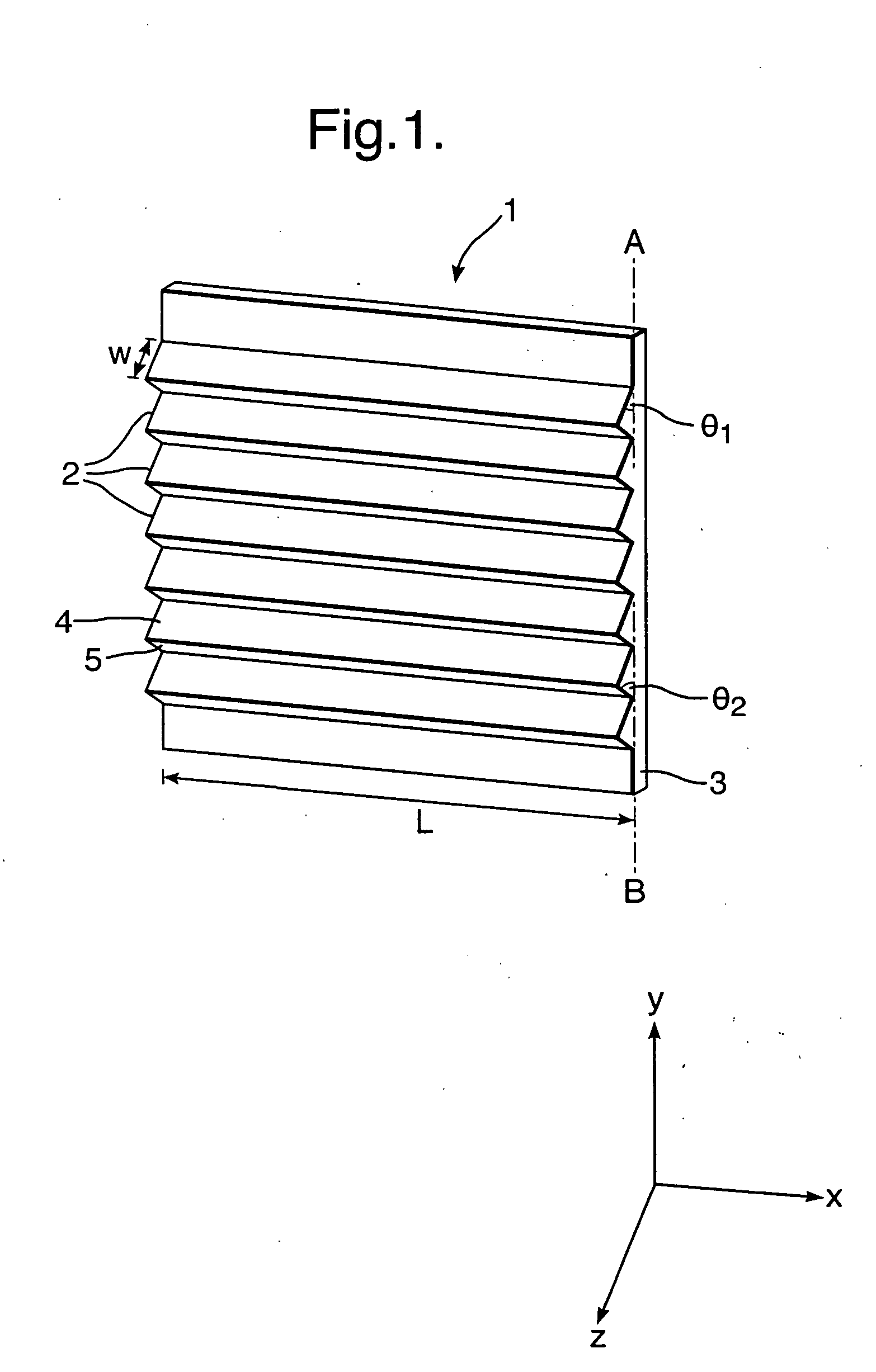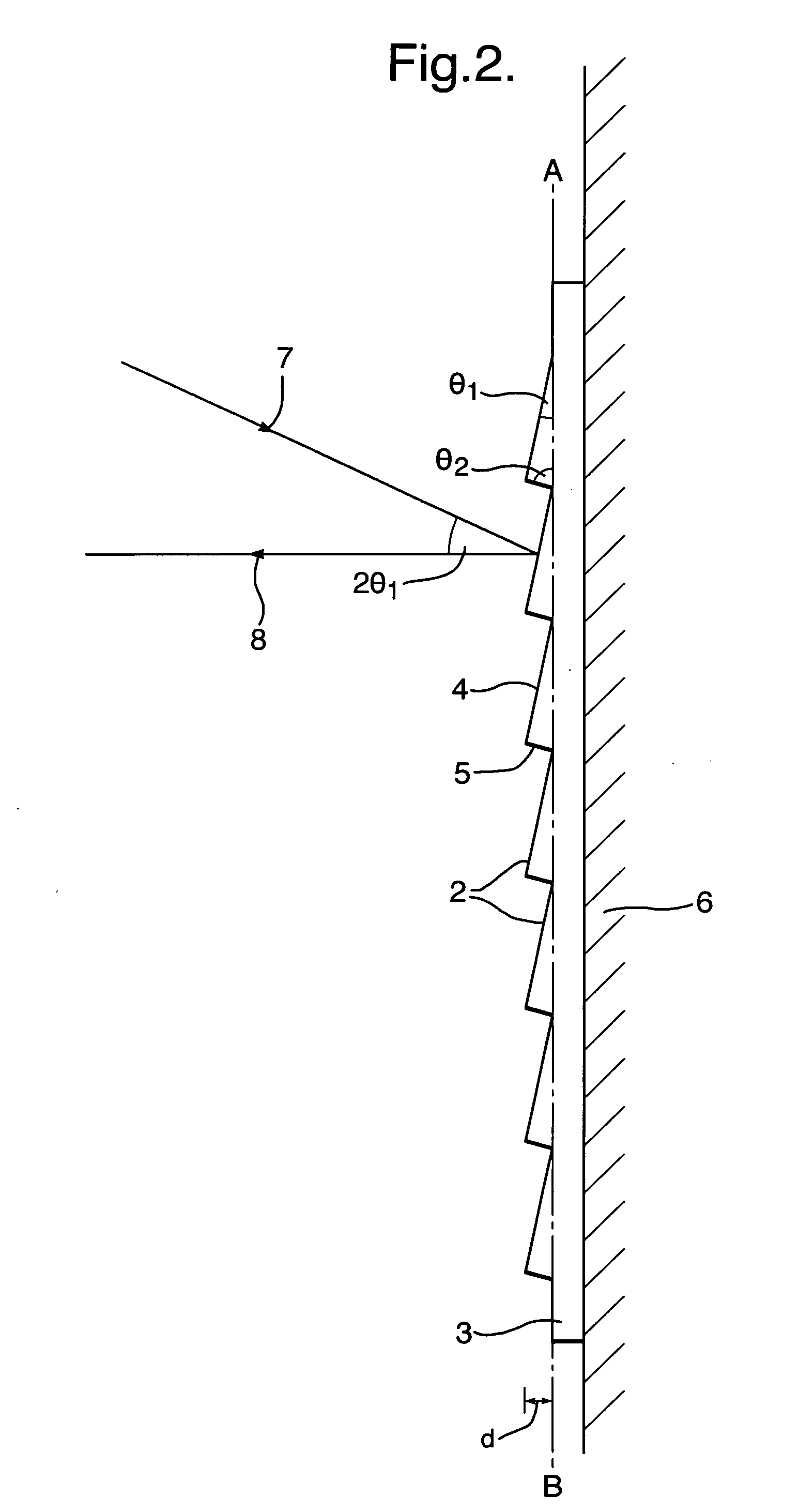Indentification device
a technology of indentification device and visible wavelength, which is applied in the direction of identification means, instruments, seals, etc., can solve the problems of limited application to ground-to-ground identification, inability to find suitable space on many vehicles, and inability to detect the background of thermal infrared wavelengths, etc., to achieve the effect of reducing thickness, reducing thickness, and being convenient to us
- Summary
- Abstract
- Description
- Claims
- Application Information
AI Technical Summary
Benefits of technology
Problems solved by technology
Method used
Image
Examples
example 1
[0082]Four sheets of thermally reflective material were machined from stainless steel, each sheet having a 20°-90°-70° sawtooth texture according to the preferred embodiment illustrated in FIGS. 1 and 2 over an area of 200 mm×200 mm. Although the major facet angle θ1 was 20° for each panel, the depth of the texture, d, and accordingly, the width, w, of the facets, was different in each case; the depths used were 2 mm, 1 mm, 0.5 mm and 0.2 mm. Panels were constructed from the thermally reflective material by cutting the sheet material to size and the panels were mounted vertically on the front of a vehicle. FIG. 7 shows a night-time 8-12 micron thermal infrared image of the vehicle taken using the FLIR imager, demonstrating that the panels worked effectively, that is, intense ‘apparently cold’ areas are visible on the vehicle. There was negligible variation in reflection efficiency between the different facet sizes.
example 2
[0083]A flexible directional reflector material was manufactured by the following method, said material having reflecting elements taking the form of parallel, equal-sized ridges with a triangular cross section (that is, the preferred sawtooth embodiment illustrated in FIGS. 1 and 2). A mould was machined from a titanium block with a repeated pattern of 20°-90°-70° prisms (that is, major facet angle 20° and minor facet angle 70°) with minor facet width 1.06 mm and major facet width, w, 2.92 mm (triangle base length 3.1 mm). The mould surface was replicated by using a filled poly vinyl chloride (PVC) moulding material to form the working mould. Onto the internal surface of the PVC mould, a thin layer of silver was deposited by silver nitrate reduction to form a sacrificial layer to ease removal of the final material from the mould and onto which subsequent layers could be electrodeposited. Onto the silver layer, a 1 micron layer of gold was electroplated and a 100 micron layer of cop...
example 3
[0085]The material of the invention can be ‘overwritten’ using conventional, self-adhesive vehicle sign-writing vinyl to create readable text, graphics or markings in both the visible or thermal infrared.
[0086]A sheet of thin-foil material having a micro-structured, thermally reflective texture was prepared by electro-forming nickel onto a fluorinated polyurethane former having a sawtooth texture according to the preferred embodiment illustrated in FIGS. 4 and 5. The major facet angle θ1 was 10°, and the major facet width, w, was 0.86 mm. The minor facet angle θ2 was 80° and the minor facet width was 0.15 mm. Once the nickel had been grown to a thickness of 100 micron, it was peeled from the pattern former and then electroplated on the working surface with 1 micron of gold. The gold-coated nickel foil was stuck to an aluminium substrate plate (800×400 mm) using a contact adhesive and the thermally reflective material was then overlaid with the letters ‘C’, ‘I’ and ‘D’ cut from self-...
PUM
| Property | Measurement | Unit |
|---|---|---|
| thermal emissivity | aaaaa | aaaaa |
| wavelength | aaaaa | aaaaa |
| temperature | aaaaa | aaaaa |
Abstract
Description
Claims
Application Information
 Login to View More
Login to View More - R&D
- Intellectual Property
- Life Sciences
- Materials
- Tech Scout
- Unparalleled Data Quality
- Higher Quality Content
- 60% Fewer Hallucinations
Browse by: Latest US Patents, China's latest patents, Technical Efficacy Thesaurus, Application Domain, Technology Topic, Popular Technical Reports.
© 2025 PatSnap. All rights reserved.Legal|Privacy policy|Modern Slavery Act Transparency Statement|Sitemap|About US| Contact US: help@patsnap.com



